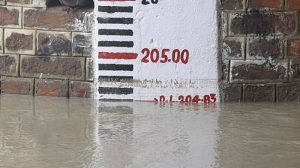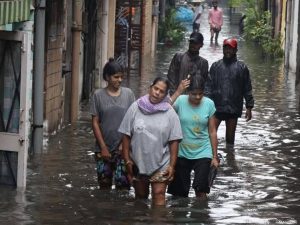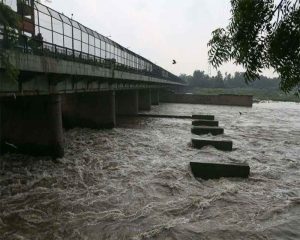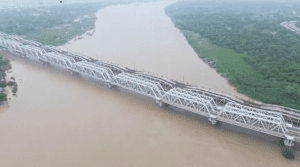New Delhi – The Yamuna Crosses Danger Level Mark at 207.39 meters by Wednesday evening, triggering massive evacuation operations across Delhi’s vulnerable low-lying areas. The Central Water Commission has issued warnings of further water level increases by Thursday morning, intensifying concerns for thousands of residents who have been forced to abandon their homes with minimal possessions.
Rescue operations are currently underway across multiple neighborhoods as the Yamuna Crosses Danger Level Mark for the first time this monsoon season, recreating scenes reminiscent of the devastating 2023 floods. Families are being ferried to safety using boats while emergency shelters are being established to accommodate the growing number of evacuees seeking refuge from the rising waters.
The unprecedented situation has transformed the capital’s landscape, with waist-deep water submerging entire market areas and residential colonies, forcing authorities to implement comprehensive emergency response protocols across the affected regions.
Monastery Market Submerged as Waters Rise Rapidly


Monastery Market became a focal point of evacuation efforts as the Yamuna Crosses Danger Level Mark, with the entrance completely submerged under waist-deep water by Wednesday afternoon. Rescue boats navigated through rows of shuttered shops, continuously ferrying evacuees to safety while shopkeepers desperately attempted to salvage whatever belongings they could carry.
Gagandeep Bhasin, a local shoe and bag seller, described the rapidly deteriorating situation, noting that hundreds of people remained trapped in colonies behind the market. He recalled beginning stock relocation early in the morning, but by 10 AM, the water had risen to dangerous levels as the Yamuna Crosses Danger Level Mark threshold was breached.
The market area, which experienced similar devastation during the 2023 floods, once again faces significant economic losses as traders struggle to protect their inventory and livelihoods from the advancing floodwaters.
Personal Stories of Displacement and Loss

Twenty-five-year-old Pinky Shamila experienced her first encounter with Yamuna flooding as the Yamuna Crosses Danger Level Mark, describing the panic that gripped her building as water levels continued rising. She was advised to carry only one small bag during evacuation, leaving behind most of her possessions while heading to Majnu ka Tilla to stay with a friend.
Prabhat Kumar faced additional challenges evacuating with his wife and two-year-old child when the Yamuna Crosses Danger Level Mark forced their displacement. Having recently purchased books, study materials, toys, and clothes for their child, the family faced the heartbreaking prospect of losing items they could not afford to replace.
Kumar demonstrated the difficult choices families face during such emergencies, ensuring his wife and child reached safety before returning by boat to salvage whatever belongings possible from their flooded home.
Comprehensive Evacuation Operations Across Multiple Areas


Evacuation drives expanded across numerous low-lying areas as the Yamuna Crosses Danger Level Mark, including Old Usmanpur, Garhi Mendu, Yamuna Bazar, Ladakh Budh Vihar, the Pakistani Hindu refugee camp near Majnu ka Tilla, Nigambodh, Geeta Colony floodplains, Madanpur Khadar, and Jaitpur.
Proactive evacuations had actually begun late Monday in several neighborhoods, including Geeta Colony, after authorities warned of surging water levels following heavy discharge from Haryana’s Hathnikund barrage. This early warning system proved crucial as the Yamuna Crosses Danger Level Mark materialized faster than initially anticipated.
Along the riverbanks, displaced families erected flimsy tents on roads, having abandoned most possessions to the flood. Their salvaged belongings lay soaked outside these makeshift shelters, continuously pounded by persistent rainfall that complicated relief efforts.
Regional Impact Beyond Delhi Boundaries
The effects of the Yamuna Crosses Danger Level Mark extended beyond Delhi’s borders, significantly impacting Gautam Budh Nagar where rising waters from both Yamuna and Hindon rivers forced families to abandon homes and farms. Nearly 600 residents and 1,400 cattle have been relocated to 15 relief shelters, with villages near Sectors 128, 150, and 155 completely inundated.
District Magistrate Medha Roopam confirmed that women, children, and livestock are being moved to safer ground, with officials maintaining round-the-clock vigilance to respond swiftly to emergencies as the Yamuna Crosses Danger Level Mark continues affecting the region.
In Faridabad, 27 villages have experienced flooding, with 14 classified as highly vulnerable. Preliminary assessments indicate approximately 250 homes are partially submerged, while crop and livestock losses are still being evaluated by relief teams working continuously to protect lives and property.
Also Read: Delhi CM Public Hearings Resume with Enhanced Security Measures
Historical Context and Unprecedented Water Levels


The Yamuna Crosses Danger Level Mark at 206 meters Tuesday evening marked the first such occurrence this monsoon season, forcing over 10,000 people to flee their homes overnight. Historical records reveal that the river has breached the 207-meter level only four times in 63 years, most recently during July 2023 when it reached an unprecedented 208.66 meters.
The 2023 floods submerged vast areas of Delhi, and current conditions have reopened those traumatic memories for residents who experienced previous devastation. Deputy Commissioner Vikram Singh emphasized that the top priority remains moving families to safe zones while ensuring continuous availability of relief materials and medical services.
Emergency Response and Relief Operations


As the Yamuna Crosses Danger Level Mark continues posing threats, seven relief camps now shelter over 160 people in Faridabad alone, with boats deployed to deliver essential supplies and rescue stranded families. Government-issued white tents stretch along National Highway-9, housing scores of evacuees from Yamuna Khadar and surrounding areas.
Near Signature Bridge, residents of the Pakistani Hindu refugee camp have erected makeshift tents for shelter from the continuing downpour, highlighting the vulnerability of marginalized communities during such disasters.
For those boarding rescue boats with hastily packed belongings, the fear extends beyond immediate water threats to concerns about what will remain when flood waters eventually recede, representing both immediate survival challenges and long-term recovery prospects for thousands of displaced Delhi residents.

